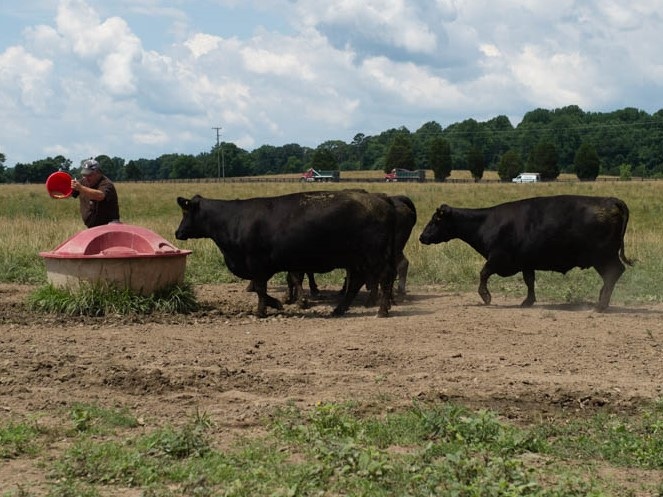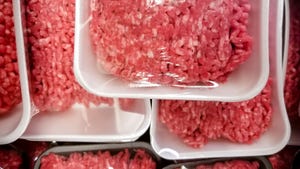Combat declining pasture quality with supplementation
It’s easier to keep up than it is to play catch-up. Provide supplemental nutrition before cool-season grasses lose forage quality and cattle drop body condition.
July 22, 2020

When the sun is shining and the heat of the summer has set in, you’d think grass would be ideal for your cattle. However, when you’re grazing cool-season grasses during the “dog days of summer,” your cattle may not be getting the nutrients they need.
There are a wide variety of cool-season forages grazed around the U.S., including fescue, brome, Kentucky bluegrass and orchardgrass. As the temperature rises throughout the summer, cool-season forages go into a transitional phase when seed head production occurs. The plant eventually stops growing and begins dropping in nutritional value, particularly protein and energy.
Cows grazing during this nutritional slump will need to eat more forage than normal. Yet, it might be physically impossible to eat enough due to the passage rate through the digestive system. As cattle eat lower quality forage, it takes the rumen longer to digest it, which in turn slows down their ability to consume more forage.
Hopefully, spring-calving cows are bred by the time forages start to decline, so they’ll be eating not just for themselves but also for a calf nursing and another in utero. Fall-calving cows face their own nutritional challenges since they’re in the last trimester of pregnancy and need to prepare for both calving and breed back. Both spring- and fall-calving cows need to keep up nutritionally to maintain performance and reproductive efficiency
4 indicators of reduced forage quality
There are four indicators to help determine when cattle are underperforming because of forage quality:
Forage appearance. If grass has a lot of stem elongation, less leaf material and more seed-head emergence, it’s in a reproductive stage and is lower in quality.
Manure appearance. When manure patties start to stack up, it’s a sign of lower digestibility and that forage isn’t providing enough nutrition
Body condition score (BCS). Hopefully, you’re already looking at your herd’s BCS throughout the year and writing it down. If you see cattle every day and are not writing down a BCS, you probably won’t notice a change until they’ve already slipped a score. Maintaining a BCS 6 should be your goal. Cows managed and maintained at 6 BCS have shown to rebreed with conception rates of 88% or better.1
Forage analysis. Forage quality can change until it has fully gone through its reproductive phase in late-summer or early-fall, which is when forage testing is ideal. For herds grazing stockpiled forage in the fall or winter, testing is a good idea because you’ll have a better idea of supplementation needs when it’s time to graze that forage.
Supplement your way out of the slump
It’s easier to keep up than it is to play catch-up. If you can maintain constant nutrition with a mix of forages and supplementation, you can keep cows in better condition rather than playing BCS catch-up later
Offering protein and energy supplementation before grass starts to go through a summer slump significantly reduces the risk of cows suffering BCS setbacks. Protein supplementation is vital because most cool-season grasses drop to protein levels below 10% during the reproductive stage. If protein levels are at 5-7%, it is difficult to meet cattle needs, especially the needs of lactating and gestating cows.
Free-choice supplements can efficiently increase protein intake and reduce labor needs compared to hand-fed supplements. Supplements can be fed via bulk feeder or offered in liquid, block or tub forms.
Another benefit of using free-choice supplements is the ability to maximize grazing distribution. For instance, you can place supplements in areas of the pasture that are underutilized and keep cows focused on grazing there.
Hand-fed supplements are another option if you want to monitor your cattle regularly and you’re set up to deliver feed on pasture efficiently.
With any nutritional plan, mineral is a critical component. Offering the appropriate mineral blend available year-round helps fill forage gaps and promotes a cow’s biological functions. Mineral blends change based on nutrient needs. During mid- and late-summer, forages typically lack enough phosphorus. Providing additional phosphorus is crucial to help feed rumen microbes and keep them thriving.
Having the right balance of nutrients for your herd is key. Speak to your nutritionist about strategies to supplement your herd before forages start to decline.
Belew is a cattle nutritionist with Purina Animal Nutrition.
Source: Purina Animal Nutrition, which is solely responsible for the information provided and is wholly owned by the source. Informa Business Media and all its subsidiaries are not responsible for any of the content contained in this information asset.
[1] Rasby, R. J., Stalker, A., and Funston, R.N. Body condition scoring beef cows: A tool for managing the nutrition program for beef herds. Retrieved Nov. 2, 2017 from: http://extensionpublications.unl.edu/assets/pdf/ec281.pdf
You May Also Like



